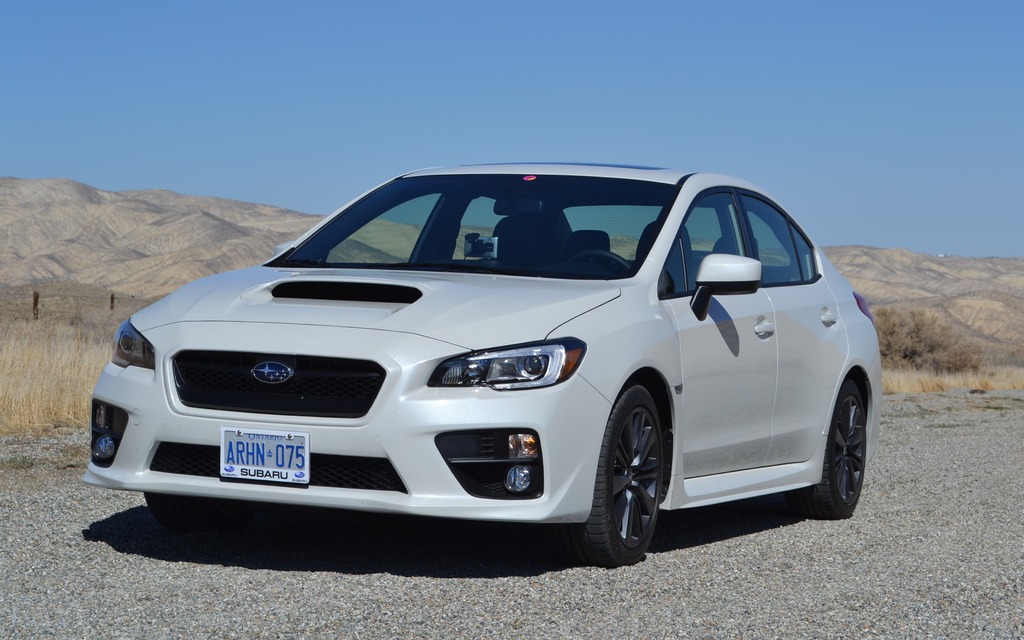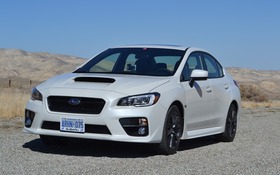2015 Subaru WRX and WRX STI: Should we be Tearing Out Our Hair?

| Strong points |
|
|---|---|
| Weak points |
|
The WRX and WRX STI have been the objects of admiration for years and, as with nearly all cult cars, every small change is carefully scrutinized by purists. Thus, people have a lot to say now that Subaru has introduced a new-generation WRX and WRX STI for 2015, in a bid to attract a greater number of buyers to both models.
The automobile market is an increasingly competitive place, and manufacturers can no longer afford to build niche vehicles. Instead, cars are being designed for the masses, a trend that upsets purists, who feel that they’ve been betrayed. And that’s exactly how long-time fans of the WRX/STI are feeling after reading about the mechanical changes made to these models. But after driving them both, we’ve concluded that there’s no need to tear out your hair in protest. Indeed, skeptics may very well be mistaken!
Similar style
It’s true that we are extremely disappointed that the five-door wagon is being retired. Despite the tremendous popularity of this configuration among Canadians, the 2015 WRX will only be available as a sedan. The brand chose to invest all of its energy into this body style for purely economic reasons. That’s too bad, since Subaru is going to lose out on clients because of this decision.
As for the new sedan’s style, you’ll have to look really closely to distinguish the new gen from the old one—especially if you’re looking at the vehicle squarely from the front or back. There’s a new cluster with the fog lamps and turn signals and the front trapezoid grille and air intake are a little lower than before. Changes are pretty scarce in the rear too, other than a new lamp style. To really notice much difference, you have to view it from the side. We get the sense that the car’s lines are a lot more generic than in the past. It looks as though it has been stretched and made sleeker, an effect that is mainly due to the somewhat shrunken front and rear sections. The most noticeable element is the position of the side mirrors, which are now anchored to the top of the door instead of the base of the A pillar.
Spot the difference
What about the differences between the regular WRX and the STI? Well, this year they are more subtle than ever, especially since the base STI no longer comes with a big spoiler. To spot the difference, check the wheels or look for the STI emblems. WRX buyers will be glad that their car looks practically the same as an STI, but the STI can no longer boast the same exclusivity as before. Other than the sizeable spoiler, it can be pretty tough to tell them apart.
In the past, our main beef with this vehicle was its interior, specifically its layout, sound system and materials, which were not up to par considering the price of the car. Subaru has made some improvements by adding a few soft surfaces here and there and making the dashboard more ergonomic. That said, there are still some hard plastics and the layout of the controls is erratic. For example, they’ve added a new information display on the upper part of the dashboard, but its control is considerably lower, located just under the button for the hazard warning lights. It would have been better to position these two together. Since the car is a little longer and comes with a wider wheelbase, the interior has more space for both passengers and cargo alike.
A CVT, are you kidding me?
And now, let’s talk mechanics. This year, the WRX has been equipped with the same engine as the Forester XT: a 2.0-litre turbocharged flat-four that develops 268 horsepower—which is two more ponies than the old mill. After being taken from the Forester, however, its performance was enhanced with more efficient valve springs. This engine comes factory standard with a new six-speed manual transmission, which not only has one more gear than before, but also a shorter shifting distance and carbon synchronizing rings.
New on the menu is an automatic continuously variable transmission. What were they thinking when they added a transmission that is traditionally anything but sporty? Masuo Takatsu, the man in charge of the vehicle’s development, stated that it was added because it is effective, helps reduce fuel consumption and (obviously) will attract new buyers who don’t appreciate manual transmissions. This transmission is also based on the one in the Forester.
For the STI’s engine, it’s status quo. The vehicle comes with the same turbocharged 2.5-litre engine as last year, which delivers 305 horsepower and 290 lbs.-ft. of torque. This year, however, it has been equipped with a sound creator, which adds a few notes to the vehicle’s interior during acceleration. The six-speed manual transmission is still the only gearbox offered in this car.
Still mighty
While not everyone loves the style and passenger compartments of these vehicles, their “athletic qualities” hold strong. Subaru engineers put most of their energy into this aspect, and it shows. No one is going to be disappointed in this regard. The chassis is almost 40% more rigid, the rear suspension's springs are firmer (+62% in the WRX and +6% in the STI) and the stabilizer bars are bigger in diameter.
As soon as you push the car, you immediately appreciate its improved handling, which is even more spectacular in the STI. The car is like a magnet on the road and you can now take corners at faster speeds. They did a lot of work on this. Few cars can offer as much for this price—and that is exactly why it’s easy to forgive and forget any drawbacks in the WRX and STI. These truly are cars built for drivers.
The sporty feel is a little more present on board now that they have added a D-shaped steering wheel, which, incidentally, is natural to hold and use. Visibility is also better with glass added near the windshield support struts. But we would have liked to have been able to lower our seats further. The telescopic steering wheel is still a nice touch.
In the end, we weren’t all that disappointed with the WRX’s Lineartronic CVT. Thanks to its pre-programmed speeds (six or eight, depending on the mode), it conveys a lot more feeling than a conventional transmission. They managed to keep the unpleasant aspects to a minimum, and the paddles behind the steering wheel give you an added sense of control. In other words, don’t write it off without trying it first.
What really sets the STI apart is its excellent constant all-wheel drive system that includes a helical limited-slip differential up front and a Torsen torque-sensitive limited-slip differential in the rear. This system enhances performance in all conditions and in corners by improving torque distribution to all four wheels. A control on the console allows the driver to select one of several modes that modify the differential's settings. The suspension also controls roll a little better, and it alone is responsible for shaving a few seconds off of the vehicle’s track times.
For years, fans have been loving these two vehicles for their energetic performance and, especially, because they are offered for a much better price than other big-name sports cars.











